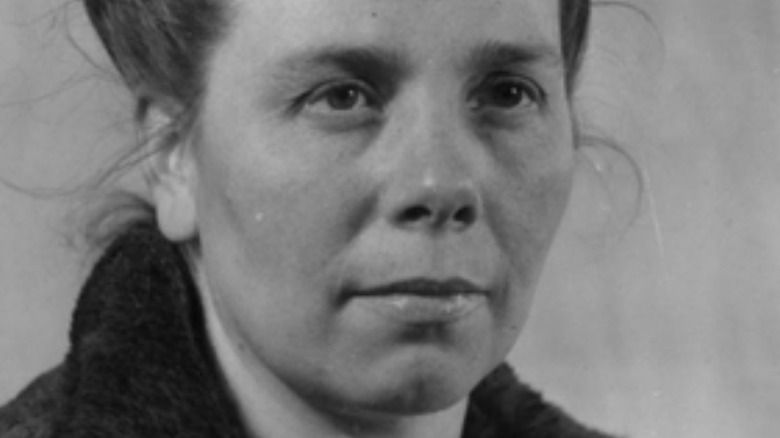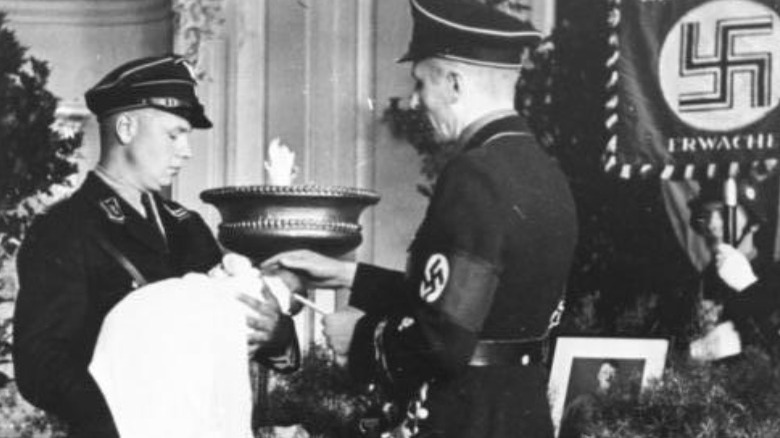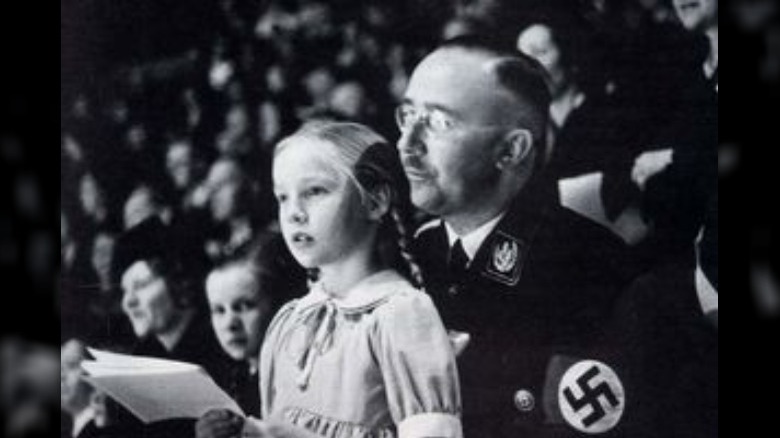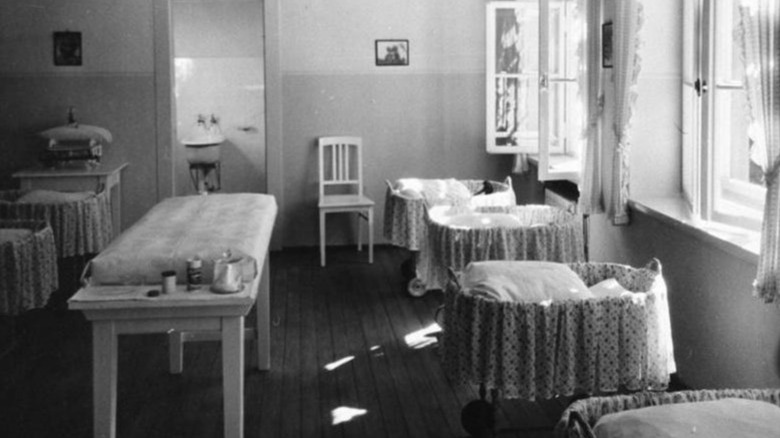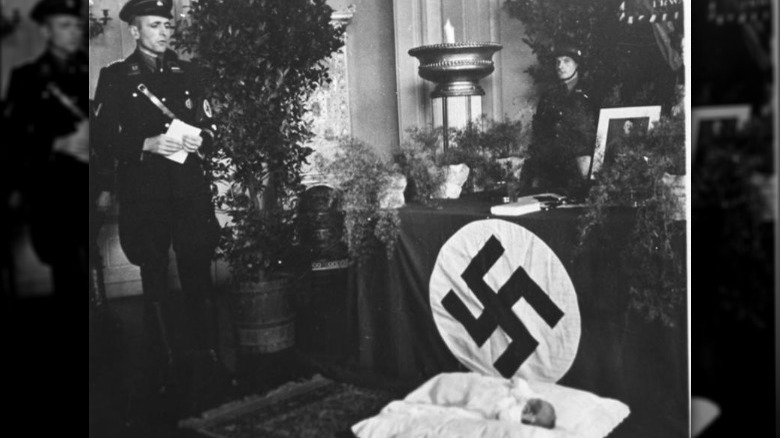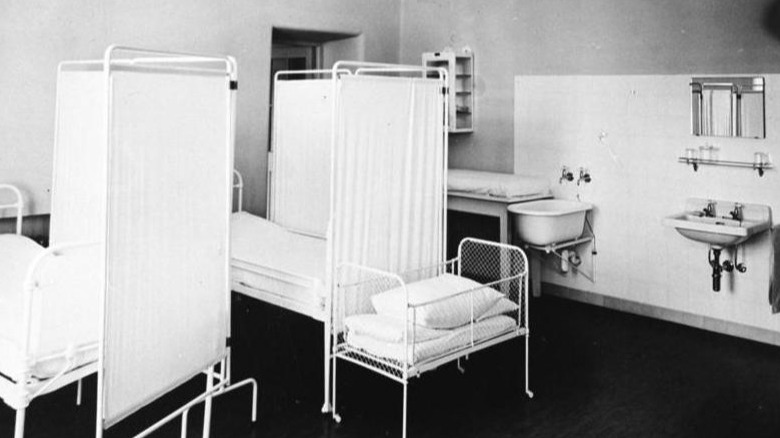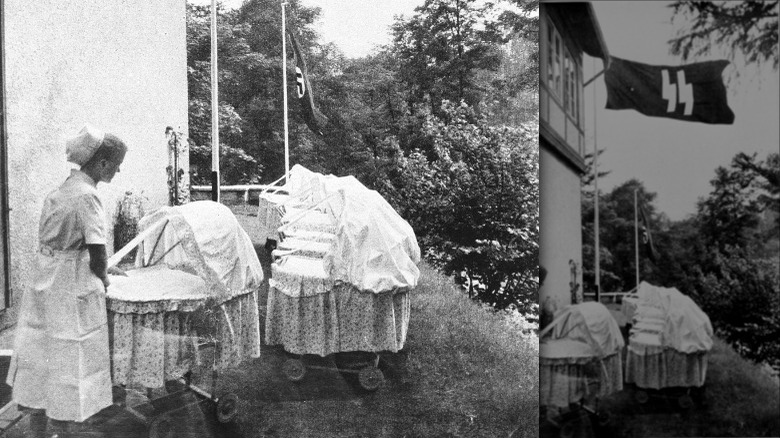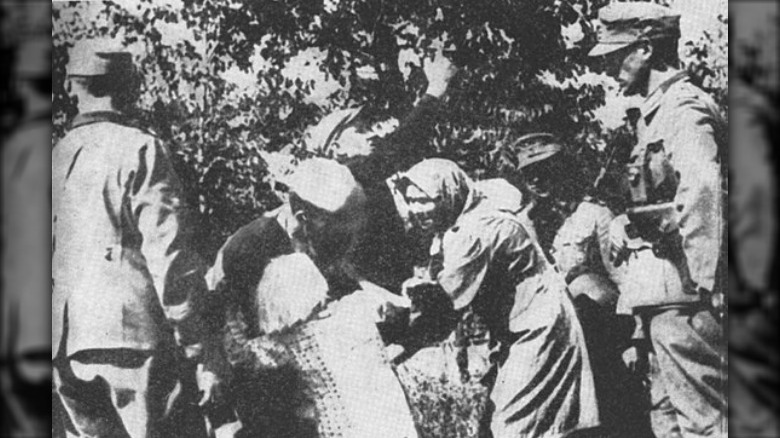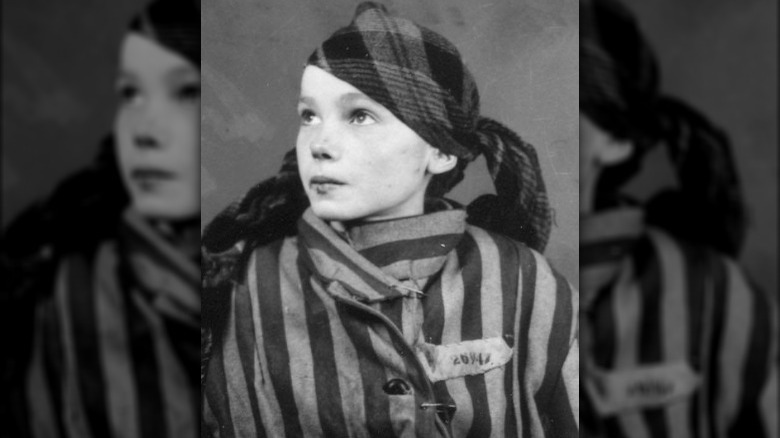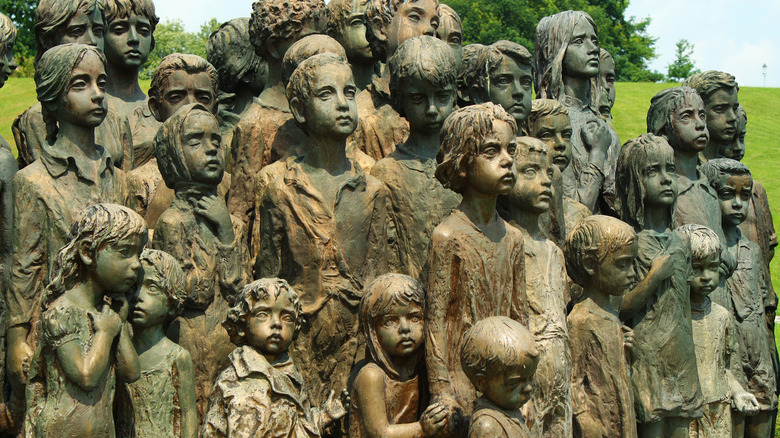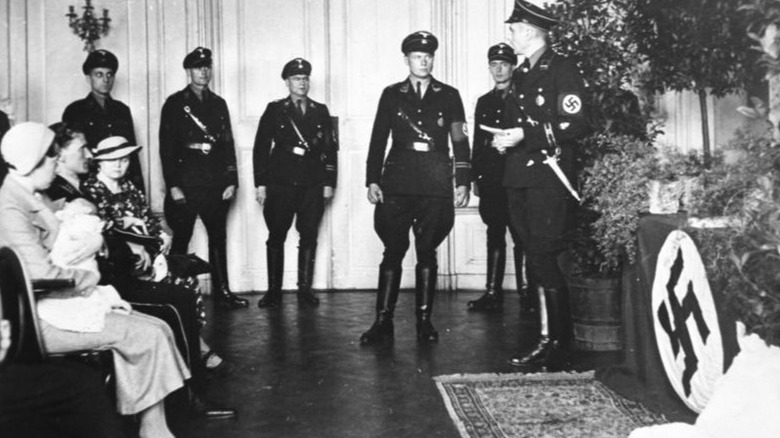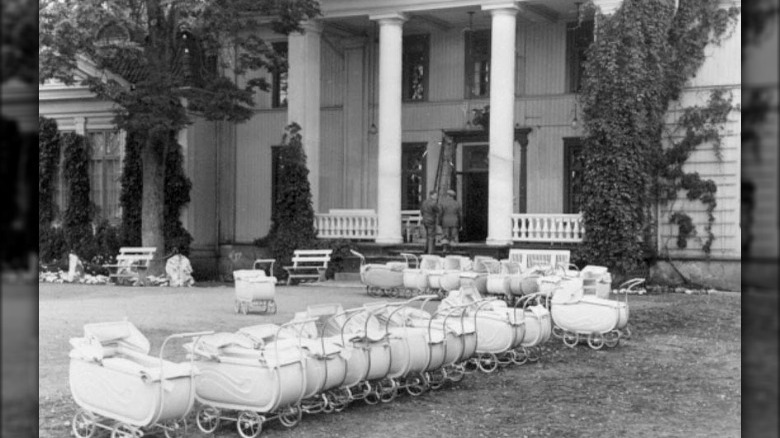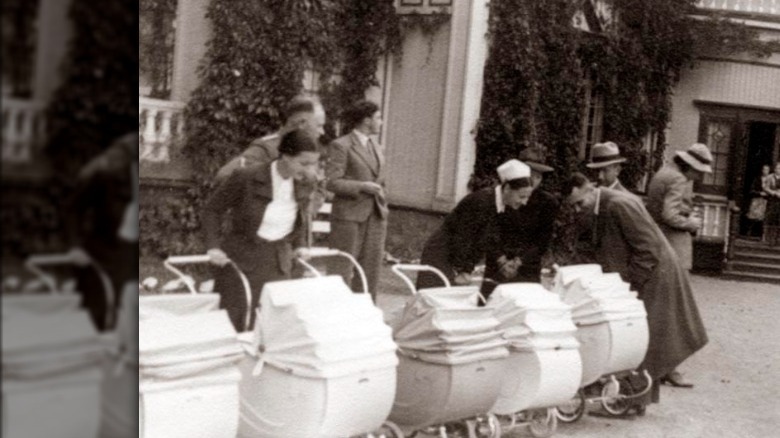The Bizarre True Story Of The Nazis' Lebensborn Babies
One of the deadliest, most tragic, and oftentimes most bizarre chapters in recent history is World War II. The sheer scale of what played out across Europe, the Pacific, and Africa was staggering, with some of the worst atrocities only coming to light after the war. And that includes the Lebensborn program, a plan designed and implemented by Heinrich Himmler, who hoped to breed more and more children that would promote and multiply his sacred Aryan race.
It's the sort of thing that doesn't just sound shocking, it sounds unbelievable. But it's absolutely true, and the babies born to women enrolled in the program — now obviously adults — are still fighting for recognition for what was done to them and to their families both during and after the war (via DW).
So what, exactly, was the program? While imagination might conjure up images of a series of brothels and birthing centers, that's not the case at all. What it really involved was much more devious — and traumatic.
What was the Lebensborn program and its goals?
"Lebensborn" means "Spring of Life," and that's what it was seen as — a way for Germany to rebuild their population of racially acceptable citizens. Estimates suggest that there were somewhere around 20,000 Lebensborn babies born across Third Reich territory.
According to Spiegel, the plan was developed by infamous Nazi leader Heinrich Himmler, and it was created in response to a major problem: the birth rate in post-war Germany had been plummeting. German loss of life during World War I had been catastrophic, and with fewer men in the country who could marry nice German girls and start a respectable family, children just weren't happening. What was happening was abortions. Statistics suggested there were around 800,000 viable pregnancies terminated every year, and Himmler wanted to give these women a place to go where they could have their baby away from prying and judgmental eyes.
It predictably turns awful really quickly. Himmler realized this was also the opportunity to control who was breeding and being born, and the Lebensborn program became a way for Nazis to lend a helping hand to "racially and genetically valuable families with many children." Yep: There it is. A series of Nazi-sponsored children's homes were set up throughout the Reich.
Racial purity, and those who didn't fit the bill
The very first of the Lebensborn homes opened in 1937 in a Munich suburb, and unsurprisingly, getting in was both tempting and tough. Unmarried mothers faced becoming estranged from families and unemployable because of the massive stigma their out-of-wedlock pregnancy still carried, and to them, the idea of getting into a Lebensborn facility to have — and surrender — their babies must have seemed like a beacon of hope shining through a very dark time.
But the Nazis didn't want all babies, just specific ones. Those were, of course, the ones that fit the Aryan ideal, so parents needed to prove their worth by providing documentation showing German ancestry back through several generations. They also needed to submit to rigorous testing, prove they didn't carry a genetic disease, that there was no history of disability, and that they were definitely not Jewish. Failing any of the criteria, says DW, would get the mother firmly turned away.
The Jewish Virtual Library says that the testing procedures were so stringent that only about 40% of the women who applied were allowed into the program, and it wasn't clear sailing from there on out. Once babies were born, they needed to meet Nazi criteria, too. Those that didn't were euthanized, starved, or poisoned.
Facilities were very nice, but...
In 1945, Life ran a whole series of photos of the babies that had been found at care facilities in the Lebensborn program, and they were kind of shocked at how healthy and well-cared for they were. Babies were described as being "grown pig-fat under care of overstuffing of Nazi nurses," while one in particular was described as becoming "so fat and healthy that he completely fills his over-sized carriage." Babies born there did get the best of care — as long as they met the criteria, that is. There were plenty of outdoor times, a regular bathing schedule, the run of playgrounds and gardens, attention from an army of nurses, and it led the magazine to ask about one child, "Did you ever see a healthier-looking youngster?" in a way that made the Nazis sound uncomfortably praise-worthy.
Sure, they were nice, but as the Jewish Virtual Library notes, they were also furnished with items hand-picked from Himmler and stolen from the Jewish families who had been shipped off to Dachau, so not-so-nice.
There was another footnote, too, and one that was of particular interest to any mother who wanted to keep her baby. The United States Holocaust Memorial Museum says that once they entered the program, the child was signed away to the Nazis. They would decide who the child was going to call "Mom," and if the birth mother wanted that to be her, she had to apply for it.
Illegitimate children and affairs were encouraged
Spiegel says that things quickly escalated — and this is also where things get a little more mysterious. As the war came to a close, most of the birth records of the Lebensborn babies were destroyed. That's made it next to impossible for thousands of people to discover the truth about their parents, and for some, it's that their fathers were SS officers who were, well, just following orders.
Himmler had encouraged members of his SS to have as many children as they could with as many Germanic and Aryan women as they could. Married? No problem! It didn't matter, and many of the children were the result of extramarital affairs.
The result is some serious heartbreaking stories, like that of Gisela Heidenreich. She was a toddler when she knew people were calling her not "Gisela," but "SS bastard." Her mother — who worked in the program as a secretary — refused to say anything about her father for decades, and it wasn't until she was grown that she met the blond-haired, blue-eyed, ex-SS officer who had been married to someone else when she was conceived. She later said that her first reaction to meeting him was that she had a father — finally — and added, "I never asked him what he did. My own reaction has helped me to understand how people in those days just put the blinders on and ignored the terrible things that were happening."
Hildegard Trutz: Why she chose to bear children for the SS
Hildegard Trutz was everything Himmler wanted in a Lebensborn mother. She explained to HistoryExtra: "I was mad about Adolf Hitler and ... how tremendously valuable we young people were to Germany." The blonde-haired and blue-eyed Trutz "was pointed out as the perfect example of the Nordic women, for besides my long legs and my long truck, I had the broad hips and pelvis built for child-bearing." She was 18 and looking for her purpose in life when a leader in the Bund Deutscher Madel — the girls' version of Hitler Youth — suggested she consider having a baby for Hitler. So, she did.
She was taken to a refurbished castle in Bavaria, with a handful of other girls and just as many SS men. After a week-long meet-and-greet, the girls picked their men, and they all did their thing. (Trutz recalled that the man she chose spent three nights a week with her, and rotated out to hook up with other women on other nights.)
Pregnant almost immediately, she gave birth, and her son was taken away two weeks later. She never knew what became of him, and while she said she had been tempted to do it again, she ended up marrying a man who "was not as pleased about [her involvement in the Lebensborn program] as he might have been." Still, it had been simple for her: it was the chance to do something for the Fuhrer.
Many children were lied to about their real parents
In 2006, The New York Times spoke to some of the Lebensborn children who had joined Traces of Life, an association dedicated to bringing the children together and helping them discover who they were. Even decades after the war, many still had no idea who their parents really were, as they'd been lied to for years.
Take Guntram Weber. His mother had always told him that his father was a soldier who died in combat, and it wasn't until 2002 that he learned that he was actually the son of a high-ranking SS officer who had been handed a death sentence at trial, then fled persecution to die in Argentina. Then, he was hit with something else: Himmler had been his godfather.
Gisela Heidenreich didn't know she was the illegitimate daughter of an SS officer until she was an adult, and she has since written a book on the Lebensborn children and mothers. She explained to Spiegel that their experiences weren't unusual: "Many women swore the SS oath. 'My honor is loyalty,' which still seems to play a role in their lives. They'd rather die than say the truth."
Still more 'racially pure' children were abducted into the program
As the relentless Nazi war machine marched across Europe, they didn't just kill as they went — they also decided the fate of countless survivors. For some — particularly Polish children between 6 and 12 years old — that meant an examination to determine whether or not they could be "Germanized."
Richard C. Lukas, author of "Did the Children Cry? Hitler's War against Jewish and Polish Children," says (via Project InPosterum) that Nazi doctrine came to preach the idea that Aryan-looking Polish children were actually Nordic, and could be taught to be German. Once they discovered this new source of children, they started kidnapping any and all Polish children who met the criteria for acceptance into the Lebensborn program. They were taken from their parents, from orphanages, and from families whose less desirable members were sent on to concentration camps.
These kidnappings were carried out overwhelmingly by the Brown Sisters, or members of the Nazi Welfare Organization (NSV). Women would head out into the streets of Polish towns, scout out prospective children, and — after doing a thorough background check — make sure the children simply disappeared. DW says an estimated 200,000 Polish children were kidnapped into the Lebensborn program.
Other children were selected from Auschwitz
The concentration camps, too, provided a source of Aryan children for transfer into the Lebensborn program. Richard C. Lukas, author of "Did the Children Cry? Hitler's War against Jewish and Polish Children," says (via Project InPosterum) that SS officers stationed at camps like Auschwitz would be on the lookout for children that met the Lebensborn criteria, and would then transfer them first to quarantine, then to other camps.
There, they were put through a rigorous evaluation that included psychological tests and the recording of physical measurements, like the length of arms and legs. Children who met all the racial and physical "points" — there were 62 areas they were tested in — were deemed worthy of being "transnationalize[d]."
In addition to the physical points, though, they also needed to pass the psychological assessment. Nazi officials were looking for children who would willingly accept their new lives as German, and who were willing to leave the past behind. They would be adopted into German families through the Lebensborn program in the same way the unwanted children of unwed mothers would be adopted, often with fake documentation and origin stories. Then, they were given German names, taught to speak German, and had their old culture and language forbidden.
The massacre of Lidice
SS General Reinhard Heydrich died in the aftermath of a botched assassination attempt in 1942, and as retribution, Adolf Hitler ordered the complete destruction of an arbitrarily-selected Czech town called Lidice. On June 9, SS and police moved in, first executing 173 men and boys. The 203 women of the village, seven would be executed along with the men, and the rest were sent to Ravensbruck, where 53 died.
According to the United States Holocaust Memorial Museum, the children were sent to Lodz, where they were evaluated for potential Germanization through the Lebensborn program. There were 80 (or 81, according to the Smithsonian) that didn't fit the criteria, and were killed at the Chelmno extermination center. The other nine were placed with German families, and after the war, 143 women and 17 of the surviving children (some of whom had been born after the massacre) returned to rebuild the town.
Among those who returned was Anna Hanfova. She was adopted by a couple with ties to the SS, who taught her that she was destined to be a slave to the Aryan race. Vaclav Zelenka returned, too. He had been three years old when Lidice was destroyed, and after drifting through a series of children's homes, he was finally adopted by a German couple. He eventually grew up to become the mayor of the rebuilt Lidice, home to the Lidice Memorial statues and rose garden.
The post-war consequences for Lebensborn mothers
During the war, the Norwegian government had set up in London in exile. According to the Independent, they were still there when they started broadcasting a warning to collaborators, and the women who had participated in the Lebensborn program: "We have previously issued a warning and we repeat in here of the price these women will pay for the rest of their lives: they will be held in contempt by all Norwegians for their lack of restraint."
When Germany left, women had their heads forcibly shaved to mark them as collaborators, then were paraded through the streets and subjected to all kinds of abuse. Thousands found themselves arrested — although there was no actual crime they were charged with — while many were sent to internment camps or psychiatric institutions, deported, or had their Norwegian citizenship revoked.
Some women faced this treatment for just having been seen talking to a German soldier. They were given the nickname of "German girls," and spent the rest of their lives being called traitors to their native land. According to The New York Times, the government didn't apologize until 2018. By then, the majority of the women were already dead.
Norway's treatment of their Lebensborn children
DW says that most of the Lebensborn homes ended up being built in Norway, where the 350,000-odd German soldiers were encouraged to fraternize with Norwegian women. Thousands of these partnerships led to children being born, and the occupying Nazis made it quite clear: These children were German. And then, the war ended. Norway decided to keep the children, but what happened to them was nothing short of unthinkable.
As the Nazis retreated, the Norwegian government issued a declaration regarding their views on Lebensborn children (via the Independent), and it's eerily familiar stuff. News outlets and high-profile psychiatrists claimed the Lebensborn babies were "genetically bad," with the government saying: "To believe these children will become decent citizens is to believe the rats in the cellar will become house pets." Children were sent to orphanages or confined to mental institutions, where they spent years. When the Lebensborn children finally started to speak out decades later, they told of being tied to their beds for days, beaten, sexually assaulted, and scrubbed so hard that their skin bled.
Few summed up the plight of the Lebensborn as succinctly as Paul Hansen, who explained: "We will never be rid of the stigma, not until we are dead and buried. I don't want to be buried in the grave, I want my ashes to be scattered to the winds — at least then I won't be picked on any more."
The most high-profile of the Lebensborn children
One of the thousands of Lebensborn children has skyrocketed to international fame, and that's Anni-Frid Lynstad (right), better known as one of the four members of the supergroup ABBA. Like many of the Lebensborn babies, Lynstad grew up not only believing that her father had died during the war, but she also grew up targeted by the discrimination that ruined the lives of so many women and children in post-war Norway.
None of what she had been told was true — according to Biography, her father was the Germany Army sergeant Alfred Haase. Haase exchanged wartime courtship gifts — including some potatoes — with the Norwegian Synni Lyngstad, and never got to meet his daughter: He returned to Germany (and his wife) before Anni-Frid was born. It was with help from fellow ABBA member (and then-husband) Benny Anderson that she tracked down her father, and finally met him. It was a bit anti-climactic, and she later said (via The Guardian), "It's difficult ... it would have been different if I'd been a teenager, or a child. I can't really connect to him..."
In spite of her reclusiveness, representatives of the Lebensborn support group Krigsbarnforbundet Lebensborn say she is nothing short of inspirational.
The Lebensborn childrens' fight for recognition
In 2007, the surviving Lebensborn children headed to court, claiming the Norwegian government had committed scores of human rights violations in the treatment of the children born into the Nazi program. According to Spiegel, they had an uphill battle in front of them, as Norway's membership in the European Convention on Human Rights didn't come until 1953. The government couldn't be held responsible for actions taken before that, but the Lebensborn children had a lifetime of misery and discrimination to draw on. Their case, says The New York Times, was deemed inadmissible. They'd waited too long.
It's been just one part of a continued struggle for recognition and justice. In 2018, some of the children kidnapped from Poland filed a lawsuit to get compensation from the German government, and they were denied. The explanation? DW says that it was reasoned that "no compensation has been paid so far to 'stolen children,'" so there was simply no category for them to file for compensation under. It was further explained that because they hadn't been singled out for being "inferior" — quite the opposite — there was no room for compensation.
Norway issued an official apology for their treatment of the Lebensborn children in 2002.
